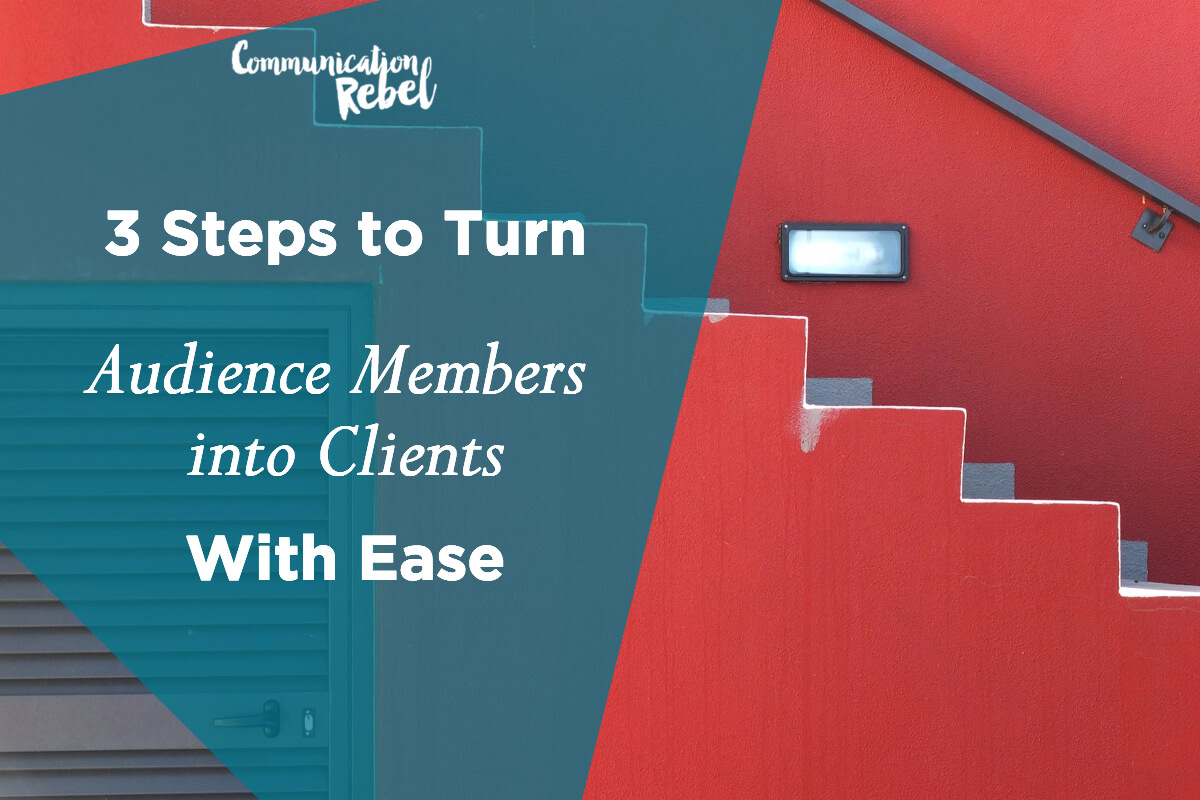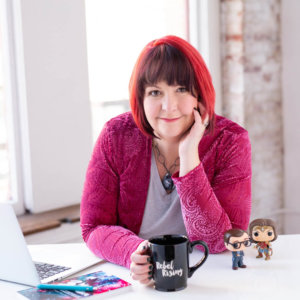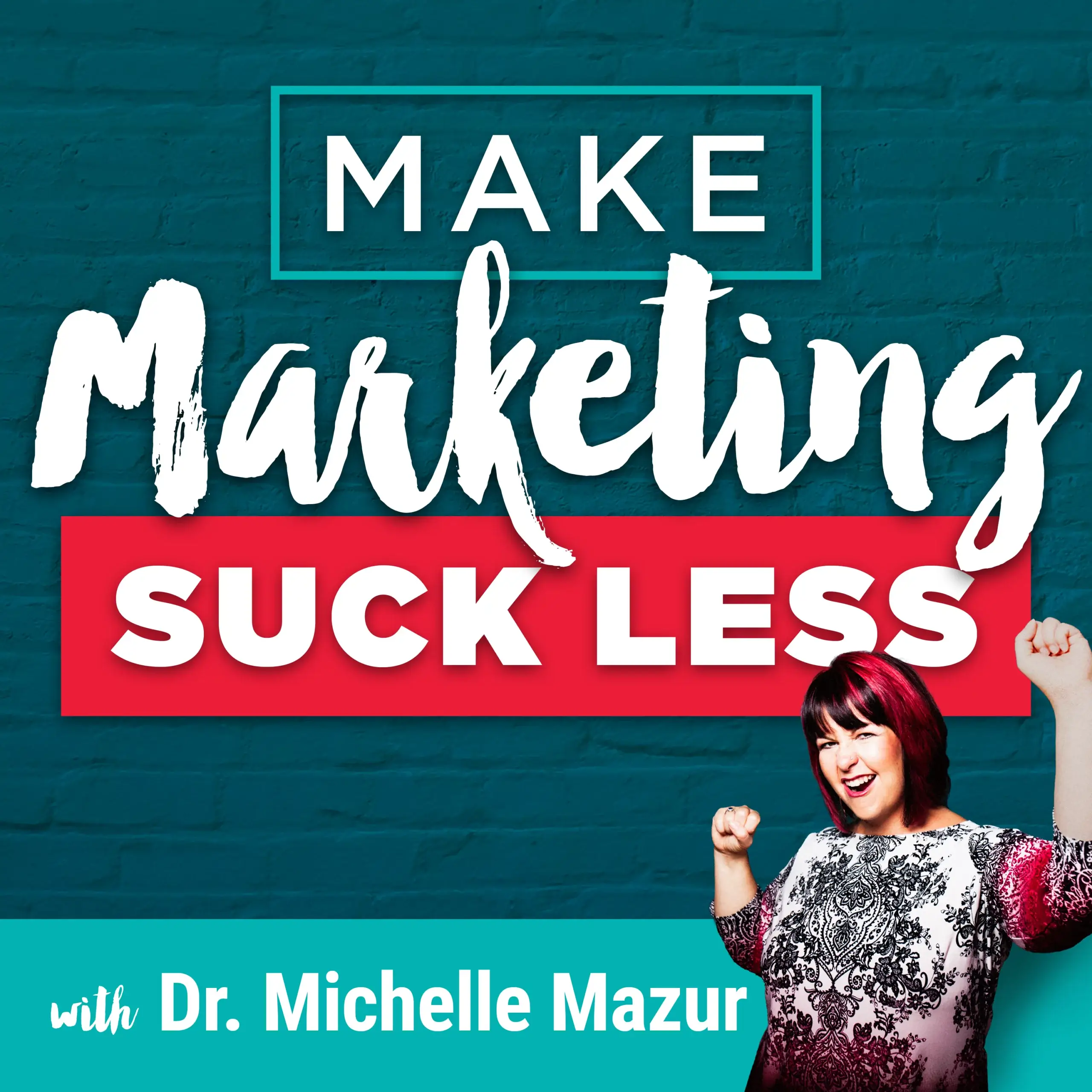Make Marketing Suck Less
3 Strategic Steps that Makes Turning Audience Members into Client Easy
By Michelle Mazur > October 10, 2017
Filed Under Book More Speaking Gigs

Confession. I fell for the speak-to-sell lie.
When I was first starting my business and struggling to get my feet underneath me, my coach at the time recommended that I look into a certain speak-to-sell course.
It was from one of the biggest names in the industry and it cost about a thousand bucks.
At that time, I was not ready to make that type of investment, so my coach gave me a copy of her own speak-to-sell talk.
I'm a pretty smart girl, so I was easily able to replicate the formula she used and then I tried out the speech.
I decided to test it out at my Toastmasters club. Now, the content part of it rocked. It was super. It felt great.
But when I got to the part about asking for the sale, I chickened out.
I totally chickened out. I couldn't do it. I couldn't ask for the sale even among friends, even among people I knew.
This was just practice. I couldn't do it.
The reason why it's because it didn't feel like me.
It wasn't the kind of person that I wanted to be. It wasn't the kind of business that I wanted to run.
I didn't want to be the person who was telling people to run to the back of the room because it's only a limited time offer. I just couldn't do that sleaze.
And, yet, these big speak-to-sell courses make promises of five-figure speaking gigs and six-figure businesses, all from speaking.
For most of us, that's the wrong strategy.
There is a better way to get clients into your business and we're going to discussing right now.
Prefer to Listen?
[interact-quiz id=”59b867453e03d90012858222″ w=”600″ h=”500″]
Strategy #1: Get Clear on Your “Irresistible Offer”
Get clear on what you're offering after the speech is over. I'm asking you to know exactly what you're selling. Speak-to-sell courses call this your irresistible offer.
You know what's irresistible to your cash flow?
A product or service that sells.
If you have something that you have sold at least three times, then you already have an irresistible offer for your business.
Now, if you don't have something that has sold yet, what I would encourage you to do is to keep reading, but work on creating an offer that your market really wants.
Speaking will be much more effective for you if you already have a product or service that sells.
What if you have multiple products or services that sell? Focus on just one.
Why? Your products and services solve different problems for your customers, so you have to make a strategic choice about which product or service to focus on to promote with your speaking.
I don't want you to think that you are limiting yourself by choosing just one product or service to focus on.
It's important to focus on just one because when we split our energy or split our speech between multiple products and services, the audience will be confused.
Options kill your focus and also kill their focus. Your action step is to pick an offer that sells, that your speaking should support.
[Tweet “Options kill. Focus on one offer!”]
Strategy #2: Start in the Right Place for Your Audience
The second strategy for a speech that converts is starting your speech where the audience is.
If you've been listening to this blog for awhile, you've probably heard me talk about how the audience comes to your speech with all of these ideas about your topic.
They show up with preconceived notions, and with their own set of problems and challenges. Your job is to meet the audience exactly where they are.
Many clients and many of you have asked me, “Michelle, how do I do that? I'm not a mind reader.” For this, I'd like to go old school with the marketing awareness spectrum.
First, a quick shout out to my girl, Tara Gentile, who taught me about this. Also a shout out to her mentor, Joanne Wiebe of Copy Hackers, who taught her. The marketing awareness spectrum has been around for eons and it is so helpful to use it to think about your audience.
To simplify the spectrum, we're going to talk about problem aware versus solution aware audiences.
Most of our audiences are aware that they have a problem.
Maybe they don't have enough money, they don't have enough time, they don't have enough clients, they are too stressed out, they are eating unhealthy, but they know that they have some problem.
That's the reason why they go see you speak. Because they have this problem that they want solved.
However, most speakers start from the vantage point of being “solution aware.”
Speak go up to the podium and explain how to do something from their point of view, from their area of expertise.
They don't really address the problem that the audience is facing and then lead them to the conclusion that their solution is actually the best solution to solve that problem.
As a speaker who is looking to get clients and customers, you always have to be thinking about that starting point first, and not your solution.
Of course, you're going to talk a little bit about that solution, but you have to lead the audience there.
Your action step is if you have a current speech, figure out where you're starting with your audience.
Are you starting with the solution or are you really addressing their problem and bring them to the solution?
They have an itch. They need it scratched. So, create a speech that leads them to what you have to offer.
[Tweet “Speakers: Start where your audience starts!”]
Strategy #3: Give a clear next step that’s not buy my thing
The final strategy is to give a clear next step for the audience that's not going to buy your product or service.
One of the mistakes I see with speakers is that their call to action, the next step that they give to the audience, is either vague or not clear.
Some people bury their call to action. (Don’t be that person)
They don't actually want to ask for the email address or for the consults, so they just put it up on a slide at the end and never really say it.
Or they don't know exactly what they want the audience to do, so they tell them, “This is how you can connect with me on all of these different social media platforms.” That is not going to lead to more clients and customers.
On the other hand, there are those speakers who have got way too MANY calls to action! (Don’t be that person either).
Maybe there's a call to action for sign up for a consult, or for this free mini-course, or let me know if you know somewhere that I should be speaking.
Those are three different calls to action and you need to pick just one.
I'm a big fan of the rule of one. I talked about it in another podcast. But it has to be just one call to action. If the audience has to think about what the right call to action is, they're not going to act.
Everyone knows that “A confused mind does not buy. A confused mind always says no.”
A final reason why that call to action isn't working is that it's too complicated to take that next step with you.
You have to get out your phone and go to a website, and then enter your email and phone number and name, and then you get the thing that was promised.
As a business owner, you have to make it easy. It has to be a no-brainer for them to take the action.
Your action step for this strategy is to develop one call to action that invites people deeper into your work and make that call to action super easy to take.
[Tweet “Develop one, simple call to action that invites people deeper”]
[interact-quiz id=”59b867453e03d90012858222″ w=”600″ h=”500″]
Remember, get clear on what you're selling. Start where the audience is and have one easy to take call to action. Then you'll be on the road to a speech that converts.
Create Your One-of-a-Kind Message
Your 3 Word Rebellion is the Key to Growing Your Business & Impact






